1997 CHEVROLET BLAZER inflation pressure
[x] Cancel search: inflation pressurePage 203 of 402
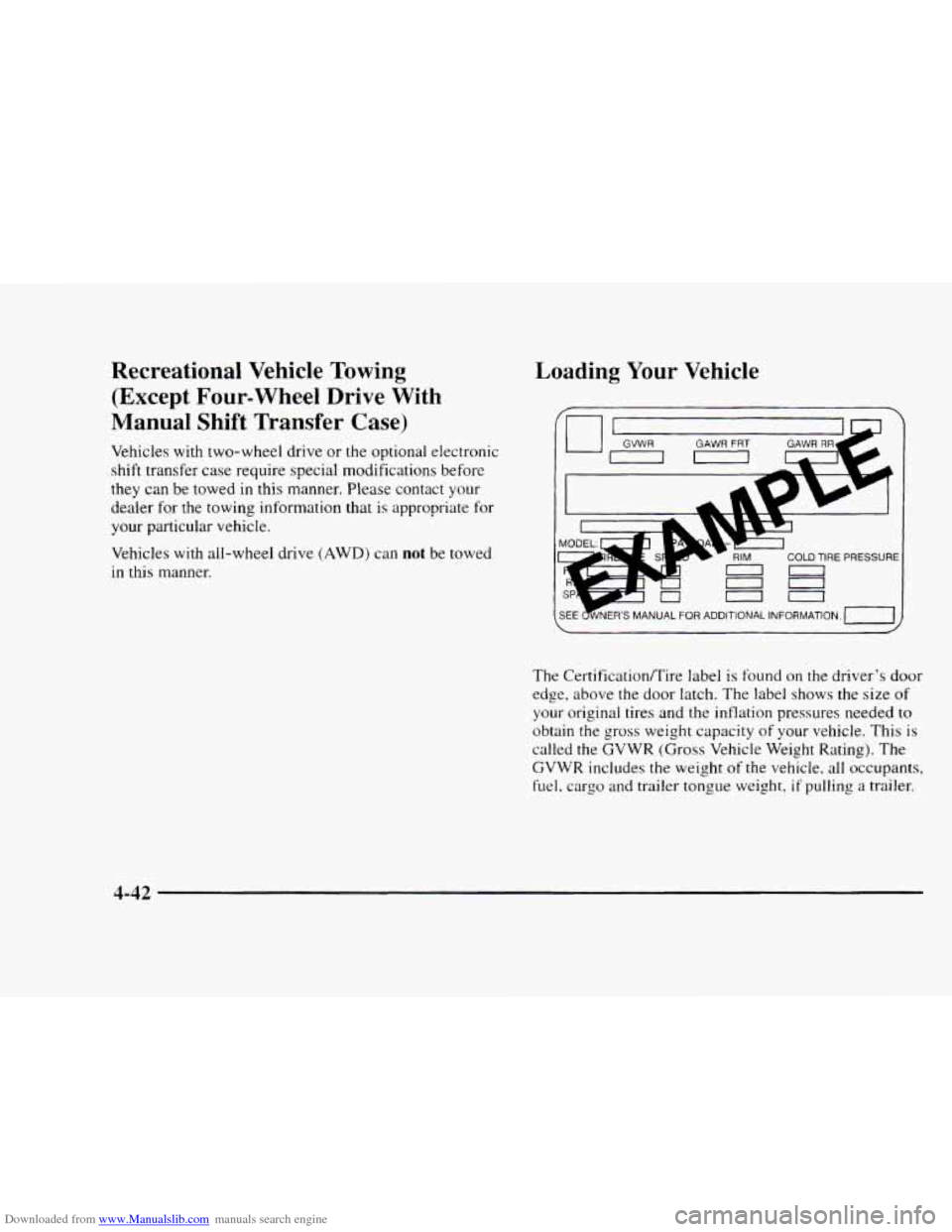
Downloaded from www.Manualslib.com manuals search engine Recreational Vehicle Towing (Except Four-wheel Drive
With
Manual Shift Transfer Case) Loading
Your Vehicle
Vehicles
with two-wheel drive or the optional electronic
shift transfer case require special modifications before
they can be towed in this manner. Please contact your
dealer
for the towing information that is appropriate for
your particular vehicle.
Vehicles with all-wheel drive
(AWD) can not be towed
in this manner.
The Certificationflire label is found on the driver’s door
edge, above the
door latch. The label shows the size of
your original tires and the inflation pressures needed to
obtain the gross weight capacity of your vehicle. This is
called the
GVWR (Gross Vehicle Weight Rating). The
GVWR includes the weight of the vehicle. all occupants,
fuel, cargo and trailer tongue weight, if pulling a trailer.
4-42
Page 252 of 402
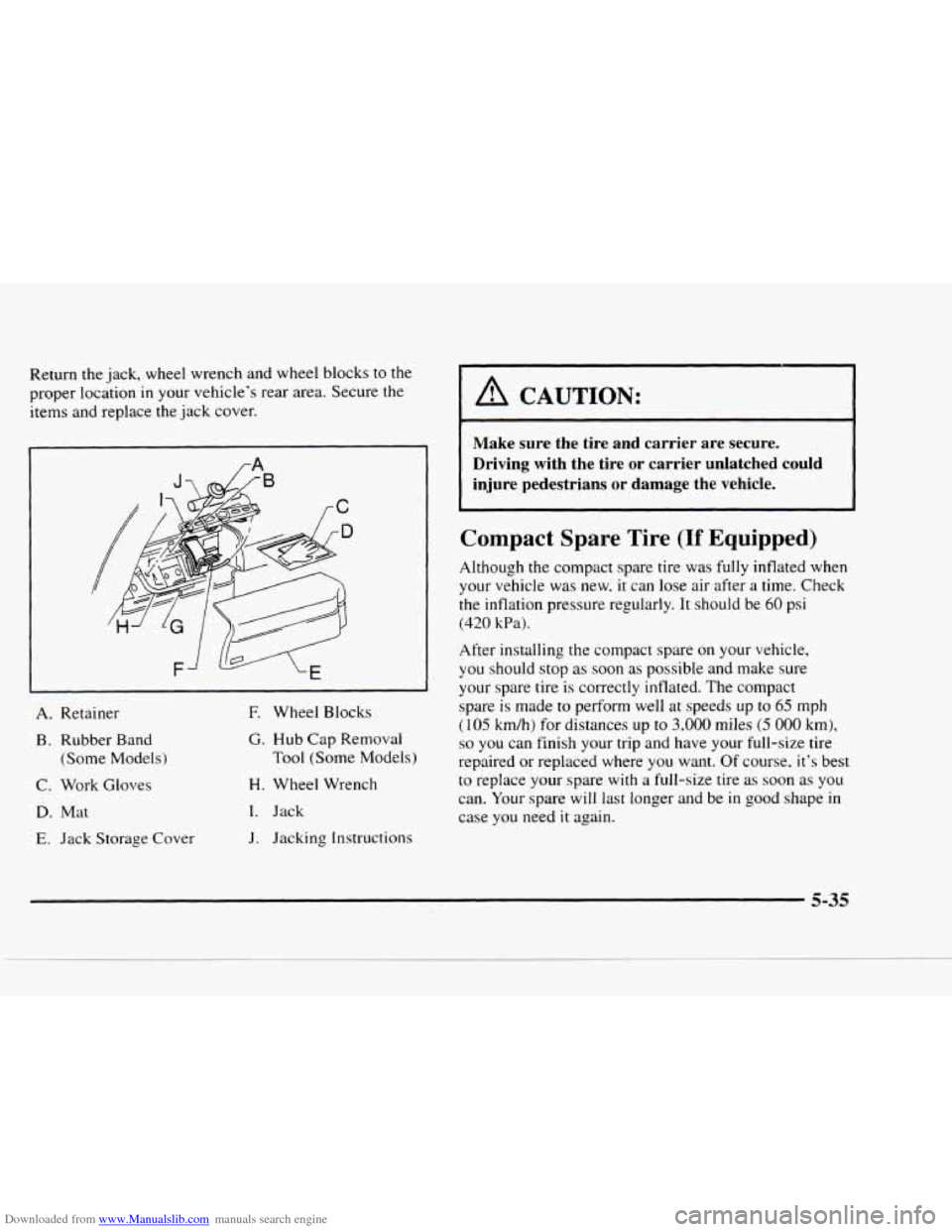
Downloaded from www.Manualslib.com manuals search engine Return the jack, wheel wrench and wheel blocks to the
proper location
in your vehicle’s rear area. Secure the
items and replace
the jack cover.
I
-
A. Retainer E Wheel Blocks
B. Rubber Band
(Some Models
j
C. Work Gloves
D. Mat
E. Jack Storage Cover
G. Hub Cap Removal
Tool (‘Some Models)
H. Wheel Wrench
I. Jack
J. Jacking Instructions
I A CAUTION:
I
Make sure the tire and carrier are secure.
Driving with the tire or carrier unlatched could
injure pedestrians
or damage the vehicle.
Compact Spare Tire (If Equipped)
Although the compact spare tire was fully inflated when
your vehicle was new,
it can lose air after a time. Check
the inflation pressure regularly. It should be 60 psi
(420 kPa).
After installing the compact spare on your vehicle,
you should stop as
soon as possible and make sure
your spare tire
is correctly inflated. The compact
spare
is made to perform well at speeds up to 65 mph
(105 km/h) for distances up to 3,000 miles (5 000 km),
so you can finish your trip and have your full-size tire
repaired or replaced where
you want. Of course, it’s best
to replace your spare with a full-size tire as soon as you
can. Your spare will last longer and be in good shape in
case you need
it again.
5-35
Page 296 of 402
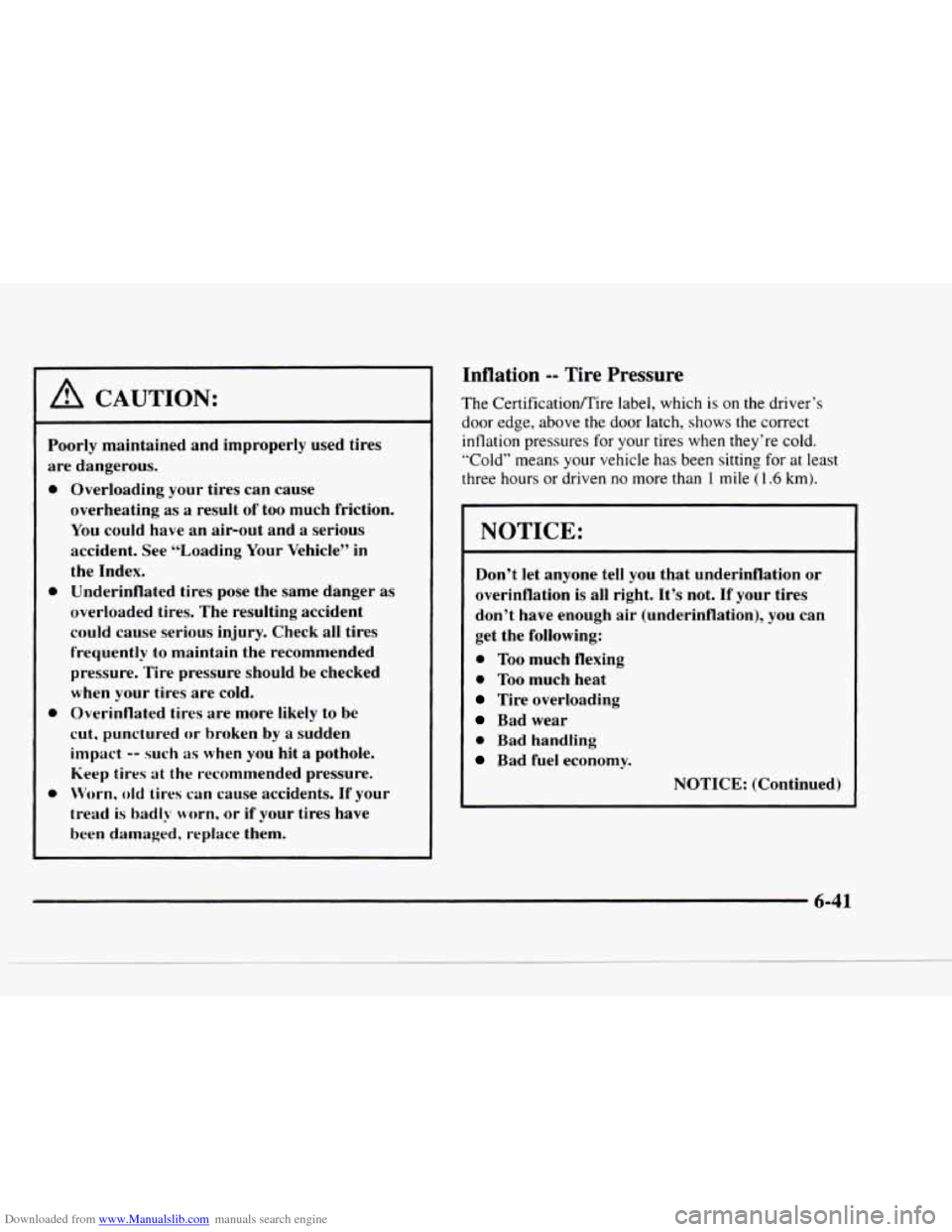
Downloaded from www.Manualslib.com manuals search engine ~ ~~~ ~~~ Poorly maintained and improperly used tires
are dangerous.
0
0
0
0
Overloading your tires can cause
overheating
as a result of too much friction.
You could have an air-out and
a serious
accident. See “Loading Your Vehicle”
in
the Index.
Underinflated tires pose the same danger
as
overloaded tires. The resulting accident
could cause serious injury. Check all tires
frequently to maintain the recommended
pressure. Tire pressure should be checked
when your tires are cold.
Overinflated tires are more likely to
be
cut, punctured or broken by a sudden
impact
-- such as when you hit a pothole.
Keep tires at the recommended pressure.
Worn, old tires can cause accidents. If your
tread
is badly worn, or if your tires have
been damaged. replace them.
Inflation -- Tire Pressure
The CertificationRire label, which is on the driver’s
door edge, above the door latch, shows the correct
inflation pressures for your tires when they’re cold.
“Cold” means your vehicle has been sitting for at least
three hours or driven no more than
1 mile (1.6 km).
NOTICE:
Don’t let anyone tell you that underinflation or
overinflation is
all right. It’s not. If your tires
don’t have enough air (underinflation), you can
get the following:
0 Too much flexing
0 Too much heat
Tire overloading
Bad wear
0 Bad handling
Bad fuel economy.
NOTICE: (Continued)
6-41
Page 297 of 402

Downloaded from www.Manualslib.com manuals search engine I NOTICE: (Continued) I
If your tires have too much air (overinflation),
you can get the following:
Unusual wear
Bad handling
Rough ride
Needless damage from road hazards.
When to Check
Check your tires once a month or more. Also. check the
tire pressure
of the spare tire.
If you have a compact spare tire. it should be at 60 psi
(420 kPa).
How to Check
Use a good quality pocket-type gage to check tire
pressure.
You can't tell if your tires are properly inflated
simply by looking at them. Radial tires may look
properly inflated even when they're underinflated.
Be sure to
put the valve caps back on the valve stems.
They help prevent leaks by keeping out
dirt and moisture.
Tire Inspection and Rotation
Tires should be rotated every 6.000 to 8.000 miles
(10 000 to 13 000 km). Any time you notice unusual
wear. rotate your tires
as soon as possible and check
wheel alignment.
Also check for damaged tires or
wheels. See "When It's Time for New Tires" and
"Wheel Replacement'' later
in this section for
more information.
The purpose
of regular rotation is to achieve more
uniform wear for
all tires on the vehicle. The first
rotation is the most important. See "Scheduled
Maintenance Services"
in the Index for scheduled
rotation intervals.
6-42
Page 298 of 402
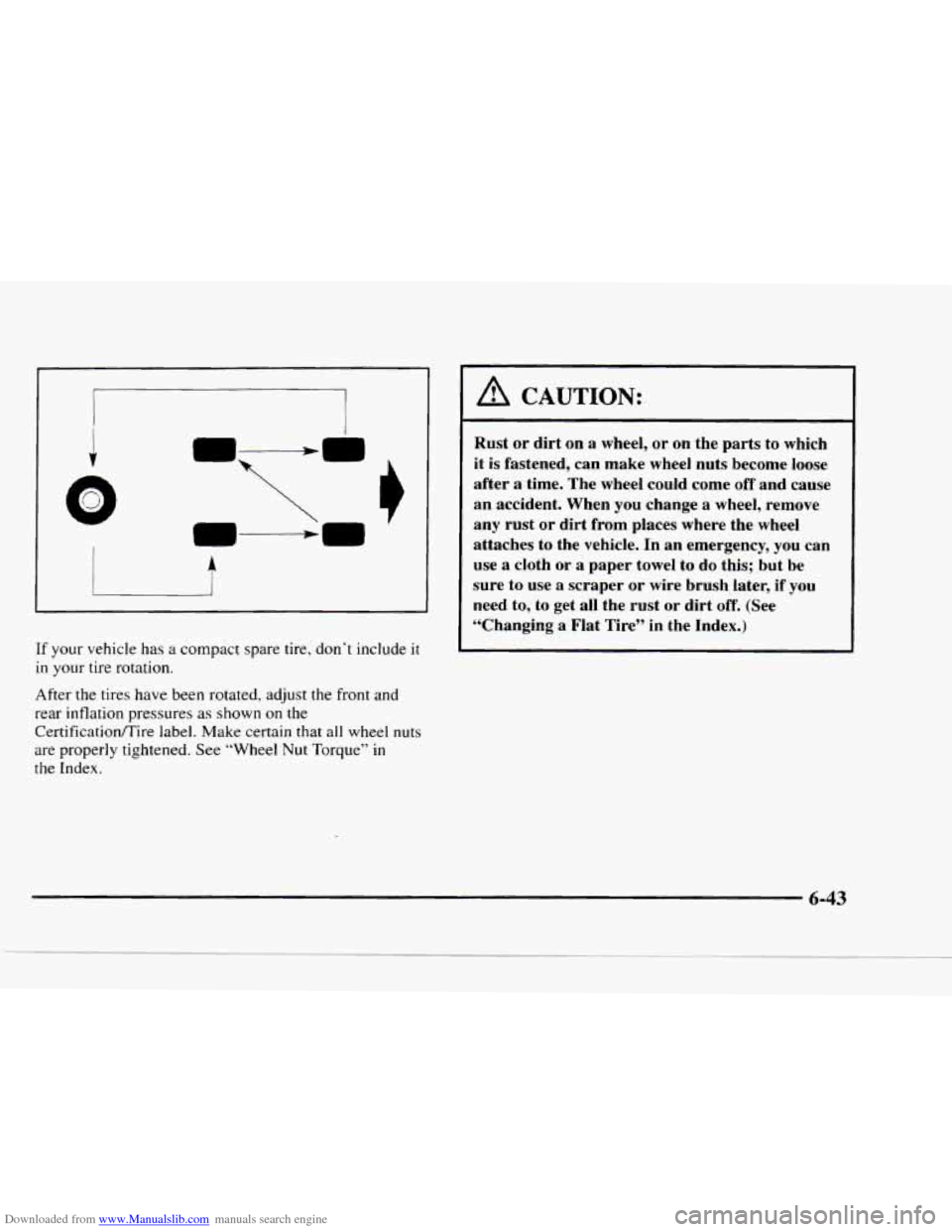
Downloaded from www.Manualslib.com manuals search engine i
I
LWA r I
If your vehicle has a compact spare tire, don’t include it
in your tire rotation.
After the tires have been rotated, adjust the front and
rear inflation pressures as shown on the
CertificationRire label. Make certain that all wheel nuts
are properly tightened. See “Wheel
Nut Torque” in
the Index.
Rust or dirt on a wheel, or on the parts to which
it
is fastened, can make wheel nuts become loose
after a time. The wheel could come off and cause
an accident. When
you change a wheel, remove
any rust or dirt from places where the wheel
attaches to the vehicle.
In an emergency, you can
use a cloth or a paper towel to do this; but
be
sure to use a scraper or wire brush later, if you
need to, to get all the rust or dirt off. (See
“Changing a Flat Tire”
in the Index.)
6-43
Page 365 of 402

Downloaded from www.Manualslib.com manuals search engine Part B: Owner Checks and Services
Listed below are owner checks and services which
should
be performed at the intervals specified to help
ensure the safety, dependability and emission control
performance of your vehicle.
Be sure
any necessary repairs are completed at once.
Whenever any fluids or lubricants are added to your
vehicle, make sure they are the proper ones. as shown
in
Part D.
At Each Fuel Fill
Engine Oil Level Check
Check the engine oil level and add the proper oil if
necessary. See "Engine Oil" in the Index for
further details.
Engine Coolant Level Check
Check the engine coolant level and add DEX-COOL@
coolant mix if necessary. See "Engine Coolant" in the
Index
for further details.
Windshield Washer Fluid Level Check
Check the windshield washer fluid level in the
windshield washer tank
and add the proper fluid if
necessarv. See "Windshield Washer Fluid"
in the Index
for
furthkr details.
At Least Once a Month
Tire Inflation Check
Make sure tires are inflated to the correct pressures. See
"Tires" in the Index for further details.
Cassette Deck Service
Clean cassette deck. Cleaning should be done every
50 hours of tape play. See "Audio Systems" in the
Index
for further details.
7-46
Page 399 of 402
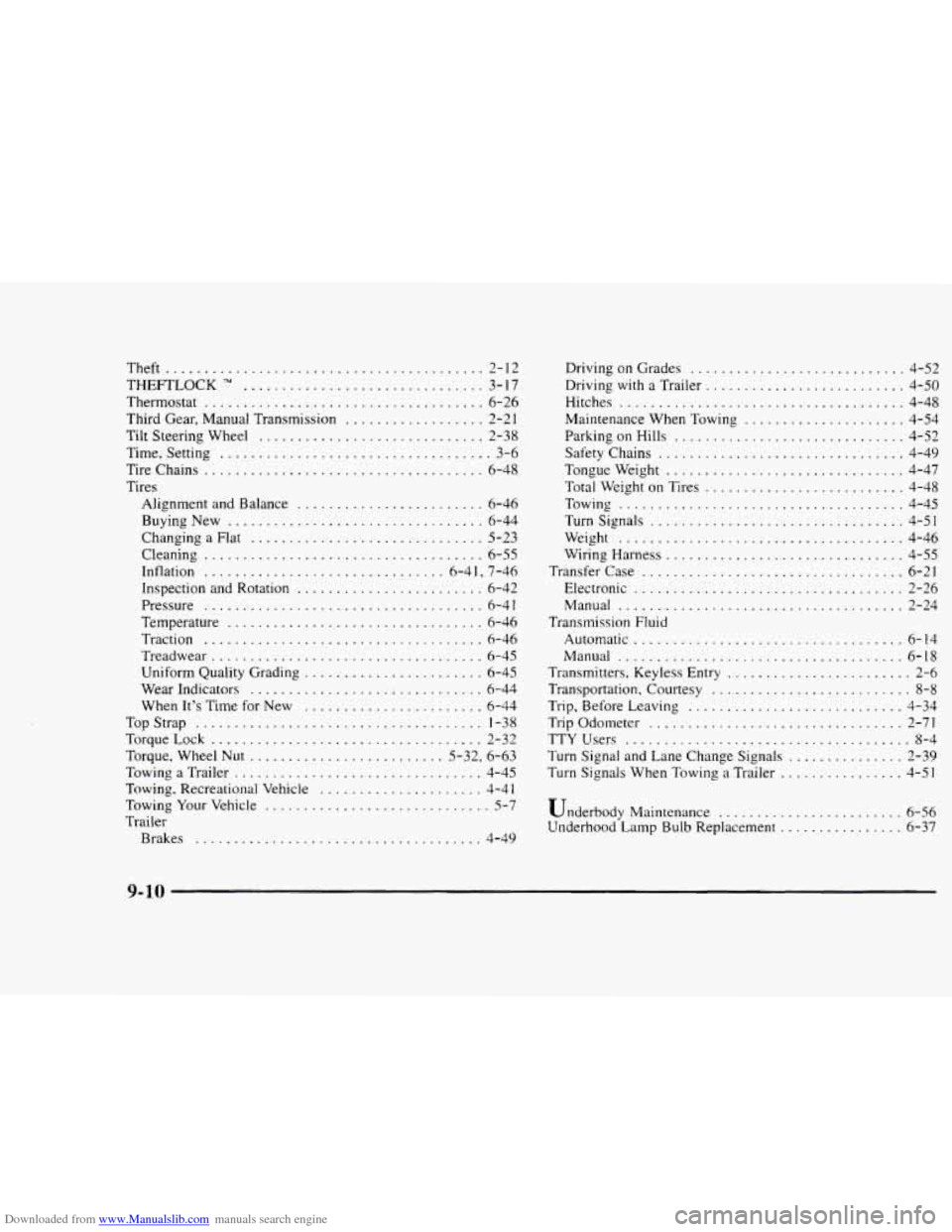
Downloaded from www.Manualslib.com manuals search engine Theft ......................................... 2-12
THEFTLOCK
TI( ............................... 3-17
Thermostat
.................................... 6-26
Third Gear. Manual Transmission
.................. 2-2 1
Tilt Steering Wheel ............................. 2-38
Time. Setting
................................... 3-6
Tire Chains
.................................... 6-48
Tires Alignment and Balance
........................ 6-46
Changing a
Flat .............................. 5-23
Cleaning
.................................... 6-55
Inflation ............................... 6-41. 7-46
Inspection and Rotation
........................ 6-42
Pressure
.................................... 6-41
Temperature
................................. 6-46
Traction
.................................... 6-46
Treadwear
................................... 6-45
Uniform Quality Grading
....................... 6-45
Wear Indicators
.................. : ........... 6-44
When It’s Time for New
....................... 6-44
TopStrap
..................................... 1-38
TorqueLock
................................... 2-32
BuyingNew
................................. 6-44
Torque, Wheel
Nut ......................... 5-32, 6-63
Towing
a Trailer ................................ 4-45
Towing, Recreational Vehicle
..................... 3-41
Towing Your Vehicle
............................. 5-7
Brakes ................................... 4-49
Trailer Driving on
Grades
............................ 4-52
Driving
with a Trailer .......................... 4-50
Hitches
..................................... 4-48
Maintenance When Towing
..................... 4-54
Parking on Hills
.............................. 4-52
Safety Chains
................................ 4-49
Tongueweight
............................... 4-47
Total Weight on Tires
.......................... 4-48
Towing
..................................... 4-45
Turn Signals
................................. 4-51
Weight ..................................... 4-46
Wiring Harness
............................... 4-55
Transfer Case
.................................. 6-21
Electronic
................................... 2-26
Manual
..................................... 2-24
Automatic
................................... 6-14
Manual
..................................... 6-18
Transmitters
. Keyless Entry ........................ 2-6
Transportation. Courtesy .......................... 8-8
Trip. Before Leaving ............................ 3-34
TTYUsers
..................................... 8-4
Turn Signal and Lane Change Signals
............... 2-39
Turn Signals When Towing
a Trailer ................ 4-51
Transmission Fluid
Trip Odometer
................................. 2-71
Underbody Maintenance ........................ 6-56
Underhood Lamp Bulb Replacement ................ 6-37
9-10